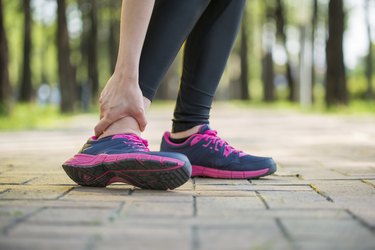
Squats are designed to strengthen your legs, abdominals and back. When completed correctly, squats are an effective strengthening workout. However, like all types of exercises, when completed incorrectly squats can cause problems, such as foot pain.
Since squats are a weight-bearing exercise, completing a squat incorrectly can lead to pain in your feet. Squats can aggravate an existing foot condition or create a new problem. Consult your doctor if you experience persistent foot pain during squats.
Video of the Day
Video of the Day
Read more: How to Stop Foot Pain With 7 Easy Exercises
Beware of Stress Fractures
Metatarsal stress fractures are common overuse injuries that are the result of repetitive stress or strain placed on the metatarsal bones. In fact, the most common locations for stress fractures are the second and third metatarsals in the front of your foot, according to Cleveland Clinic.
Metatarsal stress fractures are the result of frequent weight-bearing activities. The pain of a stress fracture is most prevalent when you participate in exercise or other weight-bearing activities such as squats.
The pain tends to subside or even disappear completely while resting. Stress fractures can be treated with rest and activity modification — participation in non-weight-bearing activities until the fracture has healed. Your doctor may also immobilize your stress fracture with a removable walking cast.
Identify Nerve Issues
Morton's neuroma is often the result of repetitive motion in your foot that places a large amount of stress on the balls of your feet. Morton's neuroma causes thickening of tissues that compress a nerve in your toes, according to the American Academy of Orthopaedic Surgeons.
Pain from this nerve condition is likely to radiate to your toes. You may also notice numbness, burning, tingling or a sensation that resembles an electrical shock. Improper form during exercise, such as performing squats while your feet are not firmly flat on the floor, may lead to Morton's neuroma.
This condition is most common in young to middle-aged women who wear ill-fitting shoes as well. The pain of Morton's neuroma will likely subside when you avoid squatting or other weight-bearing exercises.
Morton's neuroma can be treated with rest, followed by squatting with orthotics to help ease the pressure placed on the balls of your feet.
Recognize Signs of Tendinitis
Tendinitis, the inflammation of tendons, can occur in the heel, foot or in the back of your lower leg. This inflammation is often the result of overuse and can occur whether you squat with or without shoes. Repetitive stress placed on your feet can lead to tendinitis.
According to a September 2015 article published by Baltic Journal of Health and Physical Activity, back squats — versus holding the weight in front of your body — increase your risk of developing tendinitis in your Achilles tendon, which attaches to your heel.
Tendinitis can also be the result of poor mechanics while squatting. It can also be aggravated by continuing to perform squats and other exercises despite your painful feet and legs. The pain of tendinitis can range from moderate to severe.
Pain often increases with participation in exercise and will tend to decrease upon rest. Tendinitis usually clears up on its own with rest, icing and participation in non-weight-bearing activities until pain has subsided.
A doctor may recommend physical therapy to strengthen and stretch your tendons, which can help prevent reoccurring tendinitis.
Consider Other Causes
Foot problems from squatting can affect your toes, mid-foot and rear-foot. Some conditions that may affect your toes include corns, calluses, blisters, toe deformities and ingrown toenails, according to Mayo Clinic.
Your forefoot may experience pain while squatting due to a strain, nerve entrapment, inflammation of the flexor tendons, cuboid syndrome, a tarsal coalition, blisters or swelling on the ankle tendons.
Your rear-foot and heel may experience pain as the result of Achilles tendinitis, bruised heels, blisters and plantar fasciitis. Proper form should always be followed while performing squats.
Your feet should be flat on the floor to support your body weight. Doing a squat with weight on your heels or midfoot only can lead to issues.
Is this an emergency? If you are experiencing serious medical symptoms, please see the National Library of Medicine’s list of signs you need emergency medical attention or call 911.